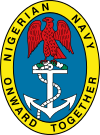Nigerian Navy
| Nigerian Navy | |
|---|---|
 |
|
| Active | 1958–present |
| Country |
|
| Type | Navy |
| Part of |
Ministry of Defence Nigerian Armed Forces |
| Motto(s) | "Onward Together" |
| Fleet | 2 amphibious tank landing ships 13 frigates 2 offshore patrol vessels 2 minesweepers 9 fast patrol boats 4 patrol cutters 4 corvettes 16 inshore patrol crafts |
| Engagements |
Nigerian Civil War First Liberian Civil War Sierra Leone Civil War Conflict in the Niger Delta Boko Haram insurgency Northern Mali War Invasion of the Gambia |
| Website | http://www.navy.mil.ng/ |
| Commanders | |
| Commander-in-Chief | President Muhammadu Buhari |
| Chief of Naval Staff | Vice Admiral Ibok-Ete Ekwe Ibas |
| Insignia | |
| Naval Ensign |  |
| Naval Ensign (1960-1998) |  |
| Aircraft flown | |
| Attack | Lynx |
| Reconnaissance | Aerostar |
| Trainer | AgustaWestland AW109 |
The Nigerian Navy (NN) is a branch of the Nigerian Armed Forces. The Nigerian Navy is among the largest Navies on the African continent, consisting of several thousand personnel, including those of the Coast Guard.
The Nigerian Navy owes its origin to the Nigerian Marine. Formed in 1914 after the amalgamation of the then Northern and Southern Nigeria, the Nigerian Marine (as it became known after 1914) was a quasi-military organization. This force expanded to become the Southern Nigerian Marine in 1893. A Northern Nigeria equivalent was formed in 1900. The two Marines were merged in 1914,. The responsibilities of the Marine included administration of the ports and harbours, dredging of channels, bouyage and lighting. It also operated ferry services, touring launches, and other small craft that plied the various creeks and other inland waterways. The first of these new organizations was the Nigerian Ports Authority, which was charged with the running of ports and ensuring safe navigation. The second organisation was the Inland Waterways Department, which took over the running of ferries and touring launches. The third organisation was the Nigerian Naval Force, made up mostly of reserve Royal Navy officers and ex-Service personnel who had been transferred to the Nigerian Ports Authority from the defunct Nigerian Marine. Its primary responsibility was to train the personnel and set up the appropriate infrastructure necessary for the planned Navy. The first basic training establishment for the future Navy - the HMNS QUORRA - was started on 1 November 1957 with 60 junior ratings, who underwent a 6-month basic seamanship course.
In July 1959, the Nigerian Naval Force was transformed into a full-fledged Navy when Queen Elizabeth granted permission for the Force to use the title ‘Royal Nigerian Navy’. The title was changed to the ‘Nigerian Navy’ in 1963 after Nigeria became a republic. The constitutional task of the Navy was expanded in 1964 after the repeal of the 1958 Ordinance. The new law, known as the Navy Act of 1964, for the first time tasked the Navy with the “naval defence of Nigeria.” Other tasks assigned the Navy by the 1964 Act were essentially coast guard duties, namely: assisting in enforcement of Customs laws, making hydrographic surveys, and training officers and men in naval duties.
These tasks were essentially routine functions of any Navy. Consequently, the naval leadership began to mount pressure on the political leadership to re-define the constitutional role of the Navy. In 1993, this pressure yielded the desired result and under a new law, Armed Forces Decree 105 (now known as the Armed Forces Act), was incorporated as part of the 1999 Constitution. The Navy was given expanded military and constabulary roles, especially in the oil and gas sectors of the Nigerian maritime economy.
...
Wikipedia
